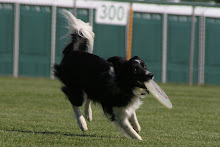I've been doing BAT (Behavior Adjustment Training) with Jun, usually once a week, for three months now. In that time I've made some adjustments, so that what I'm doing is really not BAT at all, but more of a hybrid of a lot of different methods for working with fearful dogs. A typical BAT session is done without treats and involves approaching and retreating from a "decoy" many times in a single session. So, if the decoy was a person standing still at 50 yards, the dog and handler would walk towards the decoy until the dog is somewhat uncomfortable, but not over threshold. The handler then waits for the dog to offer a calming signal (generally a look-away, or sniffing the ground), marks, and rewards the dog by turning and walking away. The reward for behaving appropriately in the presence of the scary thing is that the dog gets what they really want--increased distance.
Jun was LOVING the increased distance part, but never really wanted to approach. And though she was "doing" everything right, she was not feeling any better about it no matter how much we worked. So I've made several modifications that seem to work a little better for us.
First, I'm using treats. BAT says it’s ok to use treats sometimes, but to give them AFTER the retreat. For Jun, this just made her even more happy to get the heck out of dodge and she started offering her calming signals earlier and earlier (when she was well within her comfort zone) because she knew that when she did, not only would she get to leave, but she would get a treat as well. So I broke the rules, and I now give the treat at the end of the approach after she offers her calming signal and she gets nothing for the retreat.
The second thing I’m doing differently is using mild tug games. Jun was not having any fun with BAT and our trainer suggested using some type of play to get her to loosen up a bit and not be so serious about the whole thing. At the same time, it’s important to be careful with this because play increases arousal and arousal can turn into reactivity. So I had to make sure not to get her too revved up. I played around with this for awhile and figured out that it works best to use intermittent play during a BAT session where she is well under threshold. If she is feeling nervous about a situation, it is harder to get her to play and when I do get her playing it is more likely to be an aggressive type of play punctuated by hard stares at the decoy vs. a soft, relaxed play. I’ve found that the best game to use is a combination of “tag and run” (I touch her lightly and then run off) with a tug on her leash.
Dr. Duxbury agreed that these were good modifications to the BAT protocol for Jun’s situation and said that I should continue doing what I'm doing. We looked at two videos that highlighted the difference between the two approaches.
In this video, I am using my modified BAT. You can see how much more loose and happy Jun gets after a little play. She is pretty relaxed and focused on me during this session. I am walking forwards until she starts feeling slightly nervous about the decoys, rewarding a look-away with food and then retreating. Here, our decoy is two people, standing still and facing here. This is a low-difficulty situation for her.
Contrast with this next video in which I am using traditional BAT in a high-difficulty situation. The decoy here is a single person over 200 yards away, but he was moving a lot, running, and doing weird things like high kicks (we just used some random guy who happened to be at the park). You can see how Jun is not engaging with me at all and is giving more hard stares at the decoy. She is really nervous here.
I told Dr. Duxbury that if I had it to do over again, I would not have even tried to do any BAT in this situation, and would have just done straight classical counter-conditioning. Feed, feed, feed, then put her away. Movement is much more important to Jun than distance is and when a person is moving around a lot there is really no way to keep her well under threshold (though she’s not barking/lunging, she is very nervous). Dr. Duxbury is hopeful that the meds will help raise Jun’s threshold, so I can do BAT with her in more difficult situations.





No comments:
Post a Comment